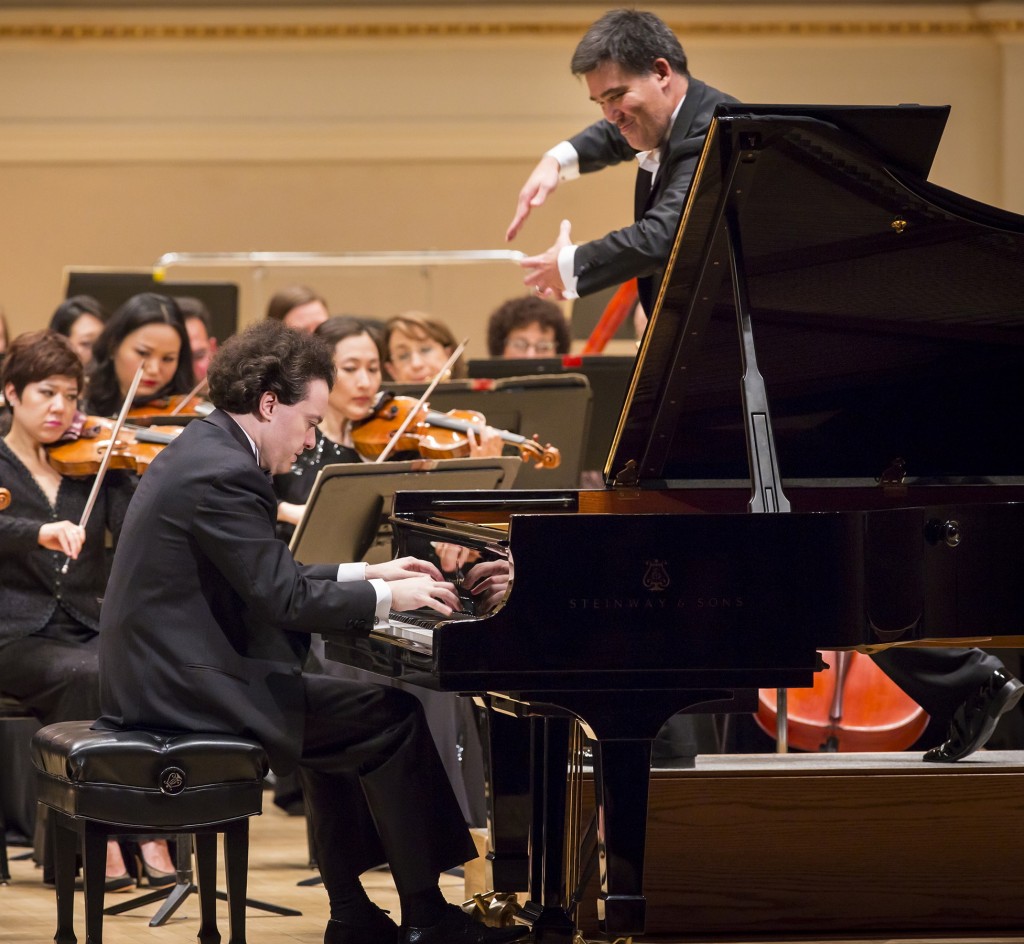New York Philharmonic, Kissin roar on Carnegie’s opening night

Alan Gilbert conducts the New York Philharmonic at opening night of Carnegie Hall with Evgeny Kissin Wednesday. Photo: Chris Lee
Opening its 125th anniversary season, Carnegie Hall indulged in a little nostalgia Wednesday night. For the venue’s gala concert the Hall was reunited with the New York Philharmonic, its primary tenant for the first 70 years of its history.
At first blush, it seemed an odd choice for an opening night program: Carnegie Hall’s particular asset is its ability to entice performers and ensembles from out of town, and particularly from across the Atlantic. The Philharmonic is an orchestra worthy of the honor, but not exactly an attraction from far afield.
Alan Gilbert and the New York Philharmonic rose to the occasion, and then some. Perhaps it was the excitement of the evening; perhaps it was the effect of playing in a hall with a warmer acoustic than their usual home; perhaps it was the influence of their vigorous new concertmaster, Frank Huang. Whatever the reason, this was some of the finest playing the Philharmonic has done in the past several years—crisp, powerful, and above all engaged.
The opening item set the tone for more than just the evening: to commemorate its 125 years, Carnegie Hall is presenting 125 new commissions over the next five seasons. The first of these to premiere was Wednesday’s Vivo by Magnus Lindberg. As a concert overture, this piece certainly does the trick. It opens with a wall of brass, not quite a fanfare, but in the blaring chords there is still a feeling of proclamation that persists through the final bars. The compositional voice Lindberg shows in this piece is difficult to pin down—structurally strong, this work seems to draw from various harmonic and textural languages, the aggressive musculature of one section giving way to reedy pleasantness in the next. Clocking in at around eight minutes, Vivo is not a momentous piece, but it is a colorful and a refreshing one.
Evgeny Kissin is a featured artist at Carnegie Hall in the coming season, marking twenty-five years since his debut recital. His performance of Tchaikovsky’s Piano Concerto No. 1 was superb, an exemplar of his hot-blooded style. On Wednesday he played on a piano with a serious roar, and it stood him well—his playing in the first movement was beautifully bright and endlessly spacious, and the Philharmonic’s strings, though disadvantaged somewhat by the deliberate tempo, answered with crackling warmth.
Kissin’s technique is unimpeachably secure, though “pristine” isn’t quite the right word—subtle blurring and cascading storminess contribute to his rhapsodic expression, even if they fitfully obscure the underlying precision of his fingerwork. Kissin’s musical intentions are always clear, and he brought to the first movement a booming sound without ever giving the feeling that he was simply mashing on the keys.
Only in the slow movement did Kissin’s playing get a touch thumpy—to some extent that is the price to be paid for choosing a piano with so powerful a voice, though he did manage to find twinkling preciousness and shafts of beaming light here and there. The Allegro con fuoco was thrilling, as any Tchaikovsky finale should be, as Kissin’s heroic playing was accompanied by a boisterous response from the orchestra.
The audience’s reception was ecstatic, and on his fourth curtain call Kissin obliged with an encore—something of a rarity on gala nights, when appetizers await at the patrons’ dinner. He offered Tchaikovsky’s Meditation in D Major, a sighing and then searing rendition, given with intense, heart-bursting passion.
The evening’s closing work was Ravel—not the gala mainstay Bolero, but the Daphnis et Chloé Suite No. 2. As though they had not shown off enough already, the Philharmonic made a terrific last impression in this piece, showing off spectacular dynamic range and a strong, unified voice in the “Lever du jour.”
The character of the “Pantomime” was gripping, achieved through a haunting hush in the strings and a ghostly, intoxicating flute solo by principal Robert Langevin. The capricious, playful skittering of winds finally gave way to a spectacular eruption in the “Danse générale,” as the Philharmonic mustered about as much volume and crashing excitement as one has ever heard from them.